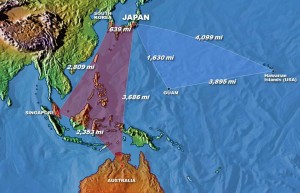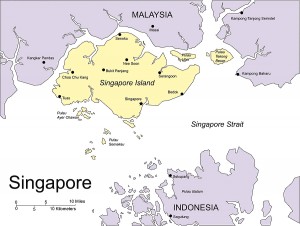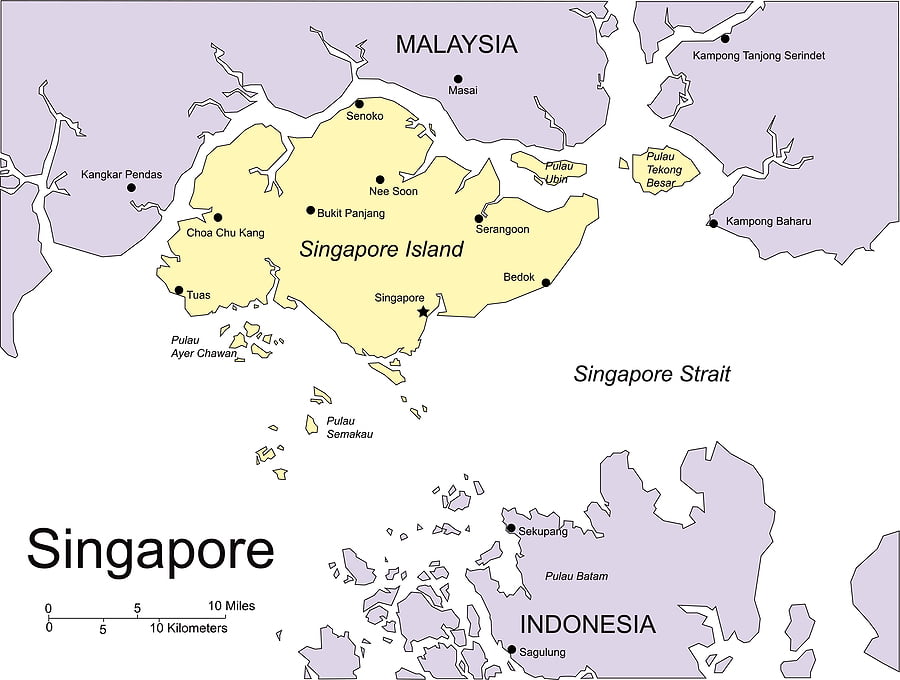2012-10-31 Singapore is at the vortex of what we are calling the Strategic Quadrangle in the Pacific.
The intersection of the defense of Japan, South Korea, Australia and Singapore forms a quadrangle of defense interests in providing for the security of key US allies in the region. The US is directly or indirectly involved in the defense of all key allies in the Quadrangle, and the evolution of their capabilities individually and collectively is crucial to the evolution of American capabilities and strategy in the decade ahead.

Singapore is a non-aligned power with close ties to the United States politically and militarily and close ties with China economically and politically. They depend on the security of maritime trade and the safety and security of the global commons.
They have built a modern naval and air force and are investing in its further modernization. And their efforts are founded on working with Western countries and firms in shaping an effective modernization strategy. And they are seeking to ensure that the force is well integrated and networked. Their concept for doing so is called an Integrated Knowledge Command and Control Concept, which is their version of the Revolution in Military Affairs (RMA).
This concept is well articulated on Singapore’s Ministry of Defense website as follows:
On the ground and in the jungles, the SAF will transform into a lean, networked and lethal fighting force while staying focused on the new security challenges. It will employ new technologies, such as precision fire, advanced communications and information technology, as well as unmanned vehicles, to defeat potential adversaries. At the same time, innovative warfighting concepts in combined arms operations, urban fighting and infantry fieldcraft will be introduced in tandem to provide the SAF with the operational edge.
Out at sea, the SAF will achieve potent three-dimensional fighting capabilities in the air, on the surface, and under the sea. Its ships will also have the command and control capability to conduct seamless operations as an integrated force with aircraft and land forces, through effective use of advanced communications and information technology, while leveraging on platform strengths. The SAF should thus be ready to meet the full spectrum of maritime threats, including small, fast-moving boats in the littorals that can otherwise pose a tremendous challenge to traditional naval forces.
In the air, the SAF will achieve Air Dominance through the coordinated employment of fighters, unmanned air vehicles and airborne surveillance aircraft, which are integrated through real-time knowledge-based systems and networks. The networked force will have comprehensive situational awareness that gives the critical edge in air operations. The SAF will also marry advanced surveillance and strike capabilities over surface threats, including elusive targets that may be concealed under foliage or ships out on open sea.
Finally, tying all these air, land and sea capabilities together into a synergistic whole is the concept of Integrated Knowledge-based Command and Control (IKC2). The concept gives commanders and soldiers the ability to see first, see more; understand better; decide faster; so that they can act decisively to achieve victory. This is achieved by leveraging on networks of sensors, shooters and communications to provide comprehensive awareness and self-synchronization on the battlefield. The networks also provide wells of information, which will also be translated into relevant knowledge for superior decision-making to achieve precise effects, and effectively shape the battlefield.
To understand the Singapore approach and its place in the world, Second Line of Defense discussed Singapore and the defense situation in Asia with Richard Bitzinger. Bitzinger is a leading expert on defense issues in the Pacific, and has focused much of his recent work on the evolving PRC policies. He teaches and works in Singapore and provides support for Singapore’s thinking about the RMA.
He is a Senior Fellow with the S. Rajaratnam School of International Studies, Nanyang Technological University, Singapore.
(For a good audio discussion with Bitzinger on the rise of the Chinese military from the Lowry Institute for International Policy see the following:
http://www.lowyinterpreter.org/post/2012/03/21/Richard-Bitzinger-on-Chinas-military-rise.aspx).
SLD: How would you describe Singapore’s defense orientation?
Bitzinger: Singapore is non-aligned. But it operates closely with the United States and allies in the region. They buy Western equipment, provide a leasing arrangement for the US navy to operate in Singapore and train in several allied facilities in the region. They train for tank warfare in Australia, they train for jungle warfare in Brunei, they do infantry training in Taiwan, fighter training in the U.S. and have a working relationship for training in France.
At the same time, they have close economic and political ties with China. A balancing act is central to Singapore’s security policies in the region.
There has been a clear shift in the past few years. Prior to this period, the main focus of military modernization for Singapore has been upon dynamics in Southeast Asia, and preparing for threats from countries like Malaysia and Indonesia. Now this concern is being superseded by the perceived need to deal with the military rise of China.
SLD: With regard to the modernization and development of their forces, and given their geography, it seems Singapore is shaping an extended defense and security bubble to surround themselves with an integrated naval and air force. Is this the case?

Bitzinger: The defense bubble concept does make sense in describing Singapore’s approach to modernization.
The Singaporeans see technology as their force multiplier. They have a conscript Army, and a relatively large mobilization force. But the ability to leverage technology to bring air, sea and ground into a more effective force is crucial to their approach.
They are creating what they call a 3G Singapore Armed Forces or 3GSAF. They are looking to shape an effective networked and integrated force with the Navy and the Air Force in the lead, with the goal of providing an intelligently informed ground force element.
SLD: It would seem then that the F-35 as a C5ISR aircraft would fit nicely into their approach?
Bitzinger: It would. They are not in a rush because they have modern F-16s and F-15s but they are already participating in the F-35 program.
SLD: And the F-35B would seem to fit their basing needs well.
Bitzinger: It would. The F35-B certainly gives you more flexibility when it comes to basing.
They only have two air force bases here and additionally have roadway-focused bases. Those are extremely difficult to use because it takes several days to get ready to use. It would help with the dispersed basing approach favored by Singapore.
SLD: How does the Chinese military modernization effort and Chinese policy in the region shape Singapore’s and others modernization efforts?
Bitzinger: The Chinese are becoming significantly more assertive and more capable at the same time. They are following a path of what I would call “creeping aggressiveness.” They have become very assertive about their territorial claims in the South China Sea, and their policies have gotten the attention of others in the neighborhood.
Historically, most of the modernization of the military in Southeast Asia has been about power balances in the region. Now it is increasingly about China.
Singapore would like to see multilateral agreements in the region to reduce tensions; but the PRC has evidenced little interest in such an approach.
SLD: How important is an effective US “pivot to the Pacific?”
Bitzinger: Very. But to date, allies in the region are disappointed about what they see as the realities of more rhetoric than reality in US policy. But make no mistake. The allies in the region cannot counter China by themselves, and are looking to the United States to play a key role in this effort.
A key element to understand the challenge is that the allies in the region tend to be ground-centric and have limited modernization programs in place for air and naval systems. The real force projection parts of their military, their navies and their air forces are still rather small. And the idea of a regionally integrated system is years away. This means that the Chinese are in a good position to pressure, if the United States is not part of the equation.
In the last two years, the United States has been looked upon by a lot of countries in Southeast Asia as we need to have you involved; we need to have you more active in Southeast Asia than ever as a hedge against the Chinese.
SLD: You have been involved for a long time in analyses of the Revolution in Military Affairs. It makes sense that you are in Singapore, because I think they take this effort very seriously.
Bitzinger: They do. For Singapore, the core concept is that of Integrated Knowledge Command and Control. They see C5ISR as a core force multiplier and an ability to reach out further with their forces, rather than having stovepiped service approaches.
It is a central tenet of their approach, and they clearly at the cutting edge of thinking on this.
And they certainly appreciate the role of the USMC in the region because the USMC is the most integrated of the American forces.


